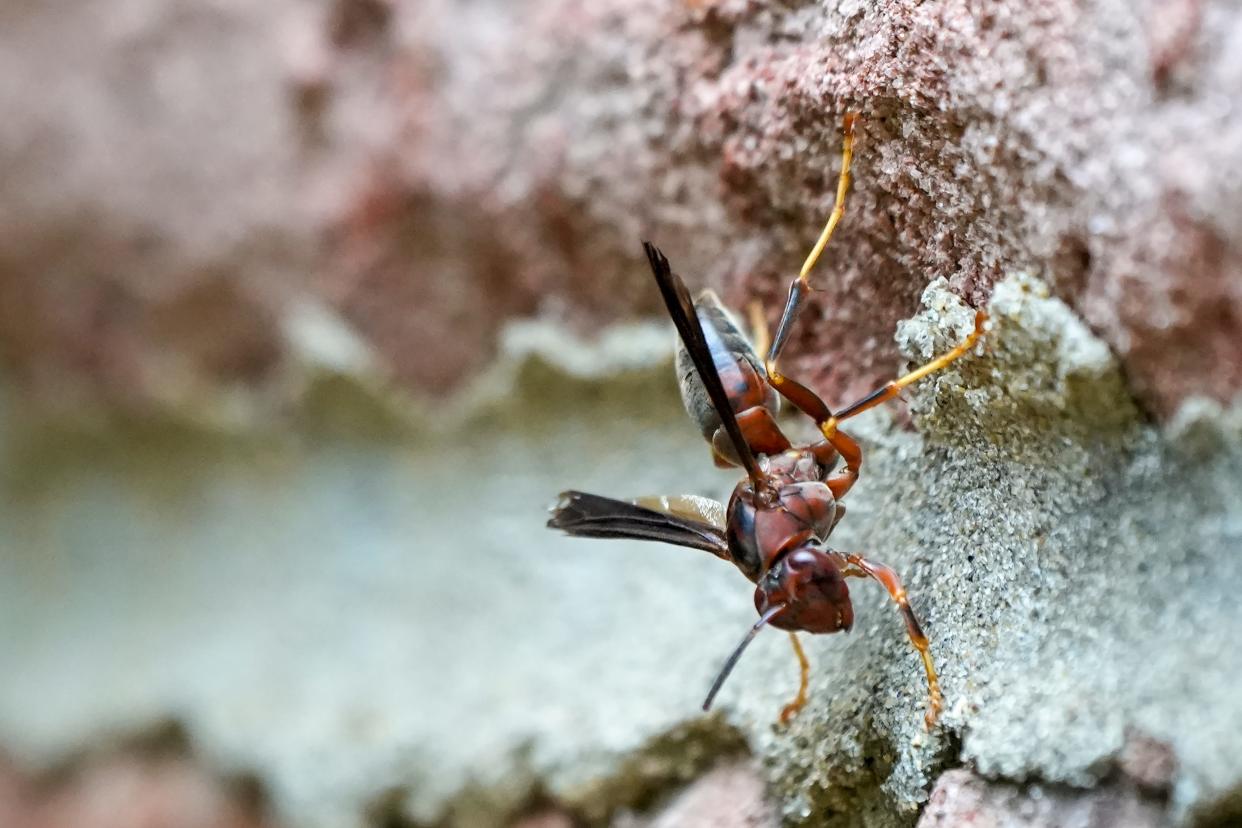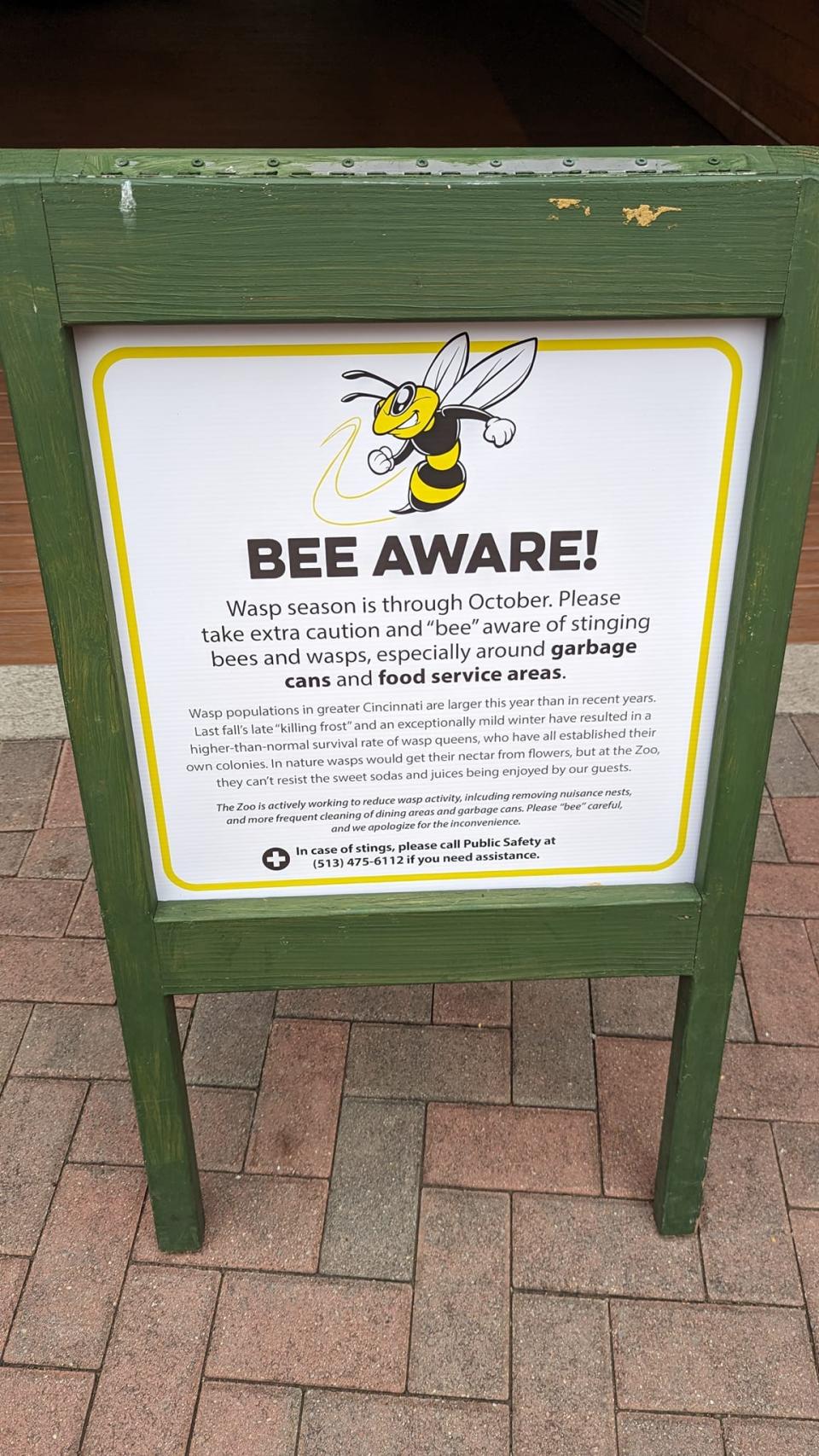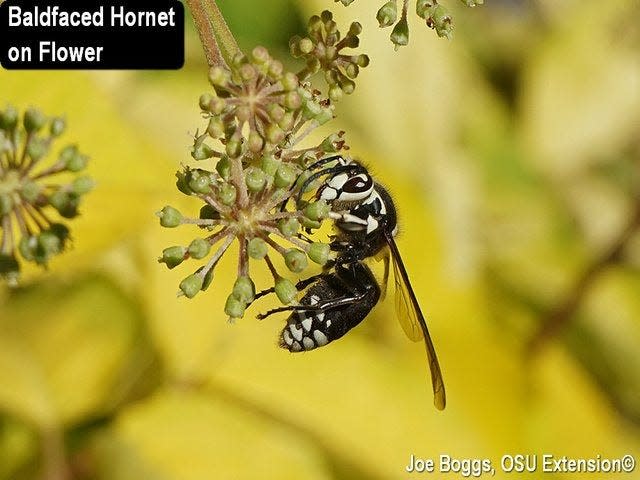Are you seeing more wasps? They're thriving in Cincinnati. Here's what you need to know

It is wasp season, and if you're thinking there are more than usual this time of year, you're probably right.
Wasps are whirring all around the Cincinnati region, diving in your cherry soda and circling your funnel cake, and it's going to be at least through October before they're gone. There's been no scientific research that shows the proliferation, said Joe Boggs, Ohio State University Extension entomologist and educator for Hamilton County. But a mild winter that preceded their season of flourishing is evidence that wasps are abundant now. That, and the fact that they're coming for your sweets.
In summer, wasps forage for protein to feed their colony’s larvae. That usually translates into them hunting, capturing and grinding up caterpillars and other insects that can destroy plant leaves. In early fall, with no more larvae to feed, wasps begin to forage for plant nectar, said Boggs.
Unfortunately, they’re equally attracted to sodas and juices, which brings them into conflict with people.
The Cincinnati Zoo & Botanical Garden has taken note, alerting visitors to pesky wasps that are interested in your treats. "We try to mitigate nuisance wasp behavior through a combination of enhanced cleaning of our outdoor dining areas, more frequent trash retrieval and the removal of nuisance wasp nests on zoo grounds,” said Winton Ray, the zoo's curator of ectotherms.

The burst in wasp activity is likely because queens, which leave their nests when winter comes and hide during the cold season, are more likely to have lived through a warmer winter, Ray and Boggs said. Then, during spring, they come out and build a new nest, preparing it for new offspring – more wasps. And the worker wasps' pattern starts anew.
Is a yellow jacket a wasp? Do they really matter to nature?
Ohio has several types of wasps. Paper wasps, yellow jackets and baldfaced hornets are all wasps, Boggs said.
They have a positive impact on the planet, and even your garden: Those caterpillars they capture, paralyze and grind up with their mandibles for immature wasps are the very bugs that eat your plant leaves. Wasps are pollinators at this time of year, flying from flower to flower as they collect nectar to keep up their energy and feed mature wasps in the nest.
So sometimes they're referred to as "pollinator-predators," Boggs said.
But they have a bad reputation, Boggs acknowledged, seen as the villains among the pollinators. And if you're not an entomologist, or if you have spheksophobia (an intense, irrational fear of wasps) or something close to that, their benefits may not seem relevant to you.
So how are we to live with or avoid (or, yes, eliminate) these predator-pollinators, as they're sometimes called?
How to react to wasps that visit your outdoor gathering
If you see a wasp or several coming near you, stay as calm as possible.
Do not swat at wasps. They aren't planning to sting you, though they likely desire the sweet treat at your table, or worse, in your fist (think, ice cream cone). If you swat at them, they will feel threatened, Boggs said, and then they might sting you.
Wear long sleeves and a hat, even gloves, if you're going to hang out around flowering plants, suggested Dr. Denise Saker, Cincinnati Health Department's interim medical director. (We know it's hot, she said.)
Keep beverages and foods covered as much as possible.
How to prevent wasps from interrupting your outside dining
Keep trash bins anywhere on the property emptied. Empty them multiple times, if necessary.
If you're visiting an outdoor location to eat, sit as far from the trash cans as possible.
Understand that other bug deterrents, such as mosquito and tick sprays, will not prevent wasps from coming your way.
But what if I get stung?
Most wasp stings are mild. Here's what you'll see and what to do:
Swelling will be about one-half to 2 inches and last from a couple of hours to two days, said Dr. Karl Schmidt, program director of St. Elizabeth Healthcare family medicine residency.
Treat mild reactions with cold compresses.
Since wasp venom is basic in pH, possible home or wilderness treatments might be to apply a mildly acidic substance, such as vinegar, to the sting for a couple of minutes, hoping that it might neutralize the basic wasp venom, he said.
You may want to take ibuprofen, said Dr. Chris Peltier, with Pediatric Associates of Mount Carmel. He likes the option because it is an antiinflammatory medicine. You may want to take an antihistamine.
For large local reactions:
Swelling can go to up to 5 inches and can increase over time, then resolve in about a week, doctors we talked to said.
Treatment includes cold compresses, antihistamines (think, Benadryl), and sometimes steroids, Schmidt said. But that's up to your doctor, if you go.
The Benadryl (diphenhydramine HCl) or Zyrtec (cetirizine) can help with itching or swelling, said Peltier.
For severe reactions:
The reaction, in 1% to 3% of cases, is not localized and includes widespread hives, swelling, shortness of breath, Schmidt said.
Act upon it swiftly, using an EpiPen or getting emergency help right away, calling 911.
Sometimes, younger children will have hives appear that will simply go away and may not be allergy-related, Peltier said. If you're uncertain about your child's reaction, even though they have no apparent breathing or throat-tightening sensations, check with your pediatrician.
Do yellow jacket traps work?
Yes, Boggs said, but if you use them, pay close attention to the wind and hang them so that they are downwind and do not draw in the wasps to food areas. If the wind shifts during your outdoor party? "Get somebody to move them," he said.
Another tip: Place traps at the perimeter of your property, not near the tables or other spots where people may be eating. Because, well, that sweet aroma can lead them to your edibles while they're on their way to an alluring trap.

Eliminating a wasp nest takes more smarts than courage
Call a professional to remove a wasp's nest if you cannot put up with one, Boggs said. It's the safest way to remove a wasp's nest.
If that's not an option, he has these tips:
Do not wave a flashlight around a nest at night, because wasps will see the light. "If they do, they'll just come after you."
Get thin red cloth or red cellophane and wrap the lamp with it or use a red light, Boggs said. Wasps cannot detect red or infrared colors.
Stand as far away as possible from the nest, and be sure to read and follow directions on the wasp spray to check distance of stream and how to use it.
Remember: The wasps are at home at night. The advantage is that you'll get them all at once. The detriment is, they may have a back door, or some may fly your way when you disturb their nest.
If it's close to the end of fall, consider letting it go. The wasps are already inside the nest dying, Boggs said.
Finally, don't go after an old nest next spring. Wasps only use a nest one time.
This article originally appeared on Cincinnati Enquirer: Wasps are everywhere this fall. Here's how to stay safe

